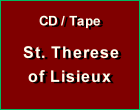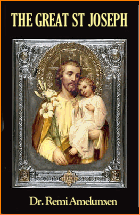Symbolism
 |
 |
 |
 |
 |
 |
 |
The Symbolism of the Easter Rabbit
Enemies of the marvelous and charming customs of Easter like to assert that eggs and rabbits were the symbol of Ishtar, the Babylonian fertility goddess, and were adapted from pagan rites. This, however, is not true. Lions, owls, gates and the eight-pointed star were symbols of Ishtar.
Rabbits are seen as synonymous with Spring and because of their fecundity (producing many rabbit kits in a litter and a short gestation period of around 31 days) they have commonly been associated with new life.
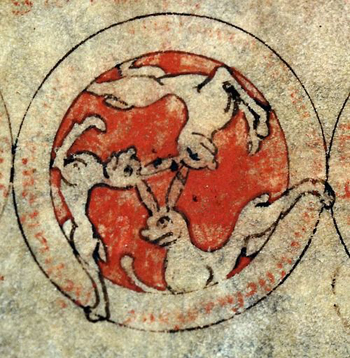 Since Ancient Times in Syria and Mesopotamia, the hare has been symbolically related to death and rebirth. Many Greek and Roman gravestones have depictions of hares on their gravestones for this reason.
Since Ancient Times in Syria and Mesopotamia, the hare has been symbolically related to death and rebirth. Many Greek and Roman gravestones have depictions of hares on their gravestones for this reason.
The Christians also saw hares in this symbolic light and associated them with death and resurrection. Thus, many early Christian gravestones include depictions of hares.
Many churches, illuminated manuscripts and breastplates throughout Europe, especially in Germany and England, depict three hares in a circle. The three ears one sees make a triangle in the center, symbolizing the Holy Trinity: "Drei Hasen und der Ohren drei und doch hat Keiner mehr als Zwei" which means "Three hares and three ears and yet none [hare] has more than two [ears]."
A symbol both of fecundity & virginity
The medieval man saw every animal that emerged in Spring to be sent by God to glorify the Risen Christ. A passage from a Sequence in the 9th century Missal of Saint Gall shows perfectly the Catholic view of Spring since the early days of the Church:
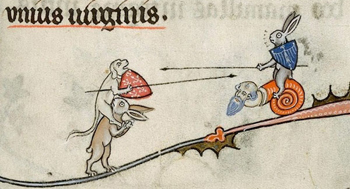
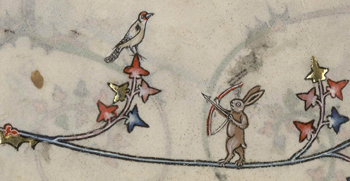 "All creatures keep a feast of joy at the Resurrection of Jesus. Flowers spring up, meadows are again clothed in their rich verdure, and birds, now that gloomy winter is past, carol in sweet jubilation. The sun and moon, which mourned at Jesus' death, are brighter now than ever. The earth, that shook at his death, and seemed ready to fall to ruin, now puts on her richest green to greet her Risen God." (p. 206 The Liturgical Year V. VIII)
"All creatures keep a feast of joy at the Resurrection of Jesus. Flowers spring up, meadows are again clothed in their rich verdure, and birds, now that gloomy winter is past, carol in sweet jubilation. The sun and moon, which mourned at Jesus' death, are brighter now than ever. The earth, that shook at his death, and seemed ready to fall to ruin, now puts on her richest green to greet her Risen God." (p. 206 The Liturgical Year V. VIII)
The prolific nature of the hare caused them to be associated with fertility and abundance. This is most apparent in the Springtime, when hares with new litters abound. Thus, hares became associated with Easter, which always falls in the Spring and is the reason for the Spring. Numerous medieval manuscripts and paintings contain delightful depictions of hares and imaginative drolleries.
Illustrating the sense of the harmonic contraries the medieval mentality understood so well, the hare was also seen as a symbol of chastity and virginity since it was commonly believed that the hare could give birth to young without another mate.
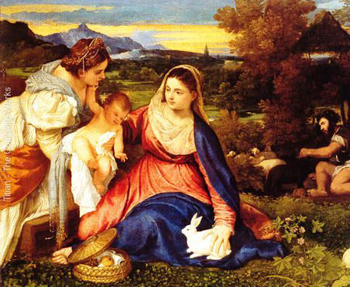 St. Hildegard von Bingen alludes to this belief when she explains in her
Physica that the male hare can appear to be female and visa versa. She goes on to explain that this is erroneous.
St. Hildegard von Bingen alludes to this belief when she explains in her
Physica that the male hare can appear to be female and visa versa. She goes on to explain that this is erroneous.
Many medieval and Renaissance paintings and tapestries include a white rabbit at Our Lady's feet to symbolize her spotless virginity, as seen in Titian's Madonna of the Rabbit shown at right.
Over time, as this symbolism and Christianity spread, rabbits were seen with the same symbolism as hares had been in ancient times.
The Easter Bunny
The first reference of the Easter Rabbit is found in a German document in the 1500's, undoubtedly representing a long standing symbolism, at least in Germany. The Germans with their ability to see the marvelous in nature would not have missed the connection between the rabbit and their Risen Lord.
It is sometimes claimed that since the custom of the Easter Bunny was brought to America by German Protestants in the 1700's, Catholics should eschew the Easter bunny and eggs. However, a study of European customs shows that the Easter Bunny is not an intrinsically Protestant invention. Rather, it developed from the remnant of Catholic spirit in the German that loves innocence and the marvelous in nature.
This tradition may not have originated with the Protestants, it could have been a custom from the Catholic days of Germany. I was not able to find sufficient sources to research this, but we cannot assume that it was invented by Protestants merely because that is the first time that the Easter Bunny is documented.
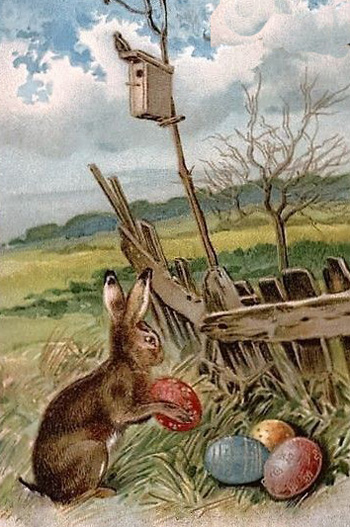 The Catholic country of Luxembourg, for example, has the tradition of hiding eggs and chocolate hidden by the Easter Bunny for children to hunt and gather. I was not able to find information on when this custom was established, but it could well be one that stems from late medieval times in German countries. What is clear is that the Catholics of Luxembourg found no problem in incorporating that custom into their Pascal celebration.
The Catholic country of Luxembourg, for example, has the tradition of hiding eggs and chocolate hidden by the Easter Bunny for children to hunt and gather. I was not able to find information on when this custom was established, but it could well be one that stems from late medieval times in German countries. What is clear is that the Catholics of Luxembourg found no problem in incorporating that custom into their Pascal celebration.
Austria, England, Switzerland, Denmark and the Netherlands all adopted this custom as well.
How did the tradition of an Easter Bunny bringing eggs for the children originate? In medieval times, hares were associated with eggs because hares (not rabbits except for one species, the cottontail) make nests in grass or rushes and a bird known as a Plover would often come and use the nest to lay its eggs. This led to the idea that hares laid eggs, and since eggs were a symbol of the Resurrection, the rabbit became part of the Easter symbology.
It was quite suitable, then, that an Easter Hare would leave beautifully colored and decorated eggs for children to announce the arrival of the great feast of the Resurrection.
Many charming customs of Easter arose throughout Europe based on the old legends. For example, in France and Belgium parents tell their children on Maundy Thursday that the bells have flown to Rome to meet with the Pope. On Easter Sunday, baskets or nests are set out in the garden and are found by the children filled with eggs of all sorts (chocolate, satin, and dyed boiled eggs), brought for good children at the Pope's command!
The idea of an Easter Bunny is derived from the rabbit's association with rebirth and resurrection as well as with virginity. This symbolism makes the hare a perfect symbol for Easter, the celebration of Our Lord's Resurrection.
Catholics should not be afraid to adopt the customs of the Easter bunny and eggs. It is not wrong for children to receive sweets on Easter. It does not take away from the focus of Christ's Resurrection. Easter baskets add to the joy and marvel of Easter Day. Children see that it is a day of marvelous and grand happenings. A day when anything is possible because of the greatest of miracles: the Resurrection of Our Lord.
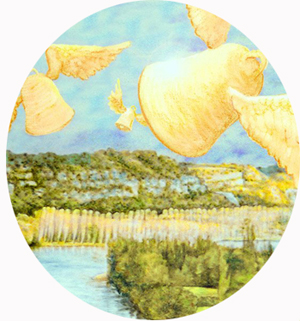

Posted May 20, 2020
Rabbits are seen as synonymous with Spring and because of their fecundity (producing many rabbit kits in a litter and a short gestation period of around 31 days) they have commonly been associated with new life.

The ears of the three rabbit make a triangle symbolizing the Trinity
The Christians also saw hares in this symbolic light and associated them with death and resurrection. Thus, many early Christian gravestones include depictions of hares.
Many churches, illuminated manuscripts and breastplates throughout Europe, especially in Germany and England, depict three hares in a circle. The three ears one sees make a triangle in the center, symbolizing the Holy Trinity: "Drei Hasen und der Ohren drei und doch hat Keiner mehr als Zwei" which means "Three hares and three ears and yet none [hare] has more than two [ears]."
A symbol both of fecundity & virginity
The medieval man saw every animal that emerged in Spring to be sent by God to glorify the Risen Christ. A passage from a Sequence in the 9th century Missal of Saint Gall shows perfectly the Catholic view of Spring since the early days of the Church:

Hares appear often in playful drollieries sketched by the monks in the margins of illuminated manuscripts

The prolific nature of the hare caused them to be associated with fertility and abundance. This is most apparent in the Springtime, when hares with new litters abound. Thus, hares became associated with Easter, which always falls in the Spring and is the reason for the Spring. Numerous medieval manuscripts and paintings contain delightful depictions of hares and imaginative drolleries.
Illustrating the sense of the harmonic contraries the medieval mentality understood so well, the hare was also seen as a symbol of chastity and virginity since it was commonly believed that the hare could give birth to young without another mate.

Madonna of the Rabbit by Titian
Many medieval and Renaissance paintings and tapestries include a white rabbit at Our Lady's feet to symbolize her spotless virginity, as seen in Titian's Madonna of the Rabbit shown at right.
Over time, as this symbolism and Christianity spread, rabbits were seen with the same symbolism as hares had been in ancient times.
The Easter Bunny
The first reference of the Easter Rabbit is found in a German document in the 1500's, undoubtedly representing a long standing symbolism, at least in Germany. The Germans with their ability to see the marvelous in nature would not have missed the connection between the rabbit and their Risen Lord.
It is sometimes claimed that since the custom of the Easter Bunny was brought to America by German Protestants in the 1700's, Catholics should eschew the Easter bunny and eggs. However, a study of European customs shows that the Easter Bunny is not an intrinsically Protestant invention. Rather, it developed from the remnant of Catholic spirit in the German that loves innocence and the marvelous in nature.
This tradition may not have originated with the Protestants, it could have been a custom from the Catholic days of Germany. I was not able to find sufficient sources to research this, but we cannot assume that it was invented by Protestants merely because that is the first time that the Easter Bunny is documented.

An Easter card in the German tradition
Austria, England, Switzerland, Denmark and the Netherlands all adopted this custom as well.
How did the tradition of an Easter Bunny bringing eggs for the children originate? In medieval times, hares were associated with eggs because hares (not rabbits except for one species, the cottontail) make nests in grass or rushes and a bird known as a Plover would often come and use the nest to lay its eggs. This led to the idea that hares laid eggs, and since eggs were a symbol of the Resurrection, the rabbit became part of the Easter symbology.
It was quite suitable, then, that an Easter Hare would leave beautifully colored and decorated eggs for children to announce the arrival of the great feast of the Resurrection.
Many charming customs of Easter arose throughout Europe based on the old legends. For example, in France and Belgium parents tell their children on Maundy Thursday that the bells have flown to Rome to meet with the Pope. On Easter Sunday, baskets or nests are set out in the garden and are found by the children filled with eggs of all sorts (chocolate, satin, and dyed boiled eggs), brought for good children at the Pope's command!
The idea of an Easter Bunny is derived from the rabbit's association with rebirth and resurrection as well as with virginity. This symbolism makes the hare a perfect symbol for Easter, the celebration of Our Lord's Resurrection.
Catholics should not be afraid to adopt the customs of the Easter bunny and eggs. It is not wrong for children to receive sweets on Easter. It does not take away from the focus of Christ's Resurrection. Easter baskets add to the joy and marvel of Easter Day. Children see that it is a day of marvelous and grand happenings. A day when anything is possible because of the greatest of miracles: the Resurrection of Our Lord.

Bells fly away on wings from France to Rome
on Maundy Thursday

Posted May 20, 2020
______________________
______________________





